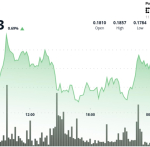Strategic accumulation and potential liquidity easing measures could breed a Santa rally, according to analysts.
Updated Nov 11, 2025, 6: 01 a.m. Published Nov 11, 2025, 5: 20 a.m.
Bitcoin’s weak October may be setting up the conditions for a year-end rebound — the so-called “Santa Claus Rally” that has historically lifted crypto markets in December.
Data from Coinglass shows that bitcoin has ended six of the past eight Decembers in the green, with gains ranging from 8% to 46%, indicating a consistent seasonal tailwind for the world’s largest digital asset.
“We’re observing a shift from panic selling to strategic accumulation by long-term holders… this recovery trajectory, bolstered by anticipated Fed rate cuts and institutional adoption, positions the market for a robust Santa rally,” Nick Ruck, director at LVRG Research said in a Telegram message.
A “Santa rally” is when bitcoin tends to rise in December as traders position for year-end optimism and light holiday trading amplifies price moves. Historically, it has finished the month higher in most years, sometimes posting strong double-digit gains.
The pattern reflects market seasonality, where prices follow recurring calendar trends driven by investor psychology, tax planning, and portfolio adjustments. In crypto, it usually signals a shift from profit-taking to renewed accumulation as traders look ahead to the new year, setting the tone for risk appetite and liquidity across the broader digital asset market.
Tariff dividend
Analysts point to U.S. President Donald Trump’s proposal of floating a $2,000 stimulus check based on tariff dividend, which some observers said could be reminiscent of the COVID-era rally
“President Trump floated a new stimulus check in the form of a $2000 tariff dividend directly to the American populace, in addition to a new 50-year mortgage to improve housing affordability,” Augustine Fan, Head of Insights at SignalPlus said.
“The ‘tariff-dividends’ are reminiscent of the covid stimulus checks that were a direct and effective money-printing stimulus, while the ultra-long duration mortgages will improve housing affordability while adding extra capital leverage to the system,” Fan added.
Both of these measures should be viewed as new forms of liquidity easing and should be positive for risk assets in general, and are treated as such so far today, Fan explained.
New vol regime
Bitcoin may be entering a new phase of volatility, not the kind driven by meme speculation or retail mania, but by deeper structural shifts in liquidity and leverage, some opine.
“Bitcoin’s volatility in 2026 will likely remain structurally elevated, though for different reasons than in past cycles,” Rachel Lin, CEO and co-founder of SynFutures, said in an email. “What we’re seeing now is the maturation of Bitcoin’s volatility. It’s less about speculative hype and more about how institutional flows, liquidity conditions, and derivatives positioning interact within a tighter global financial framework.”
“From a macro lens, the two variables to watch are global liquidity and real rates. Bitcoin’s





